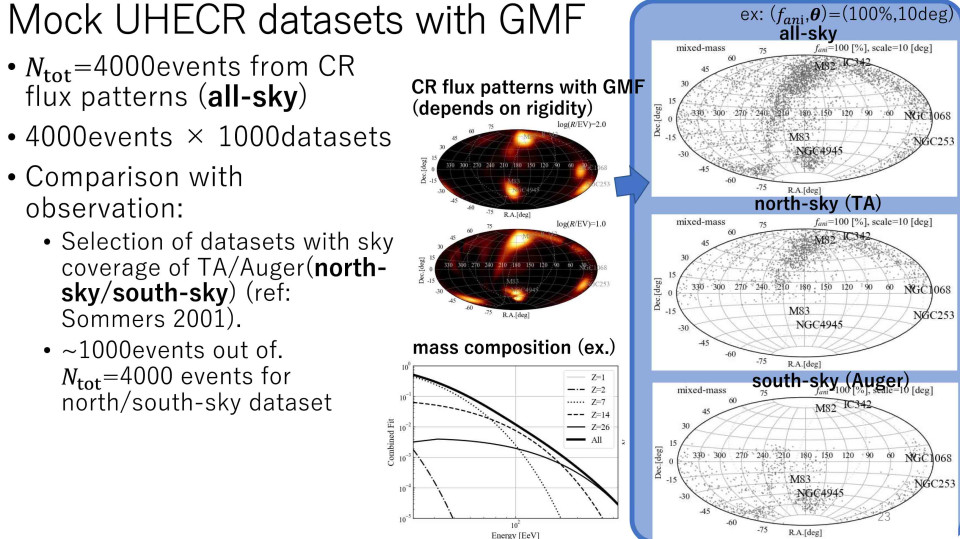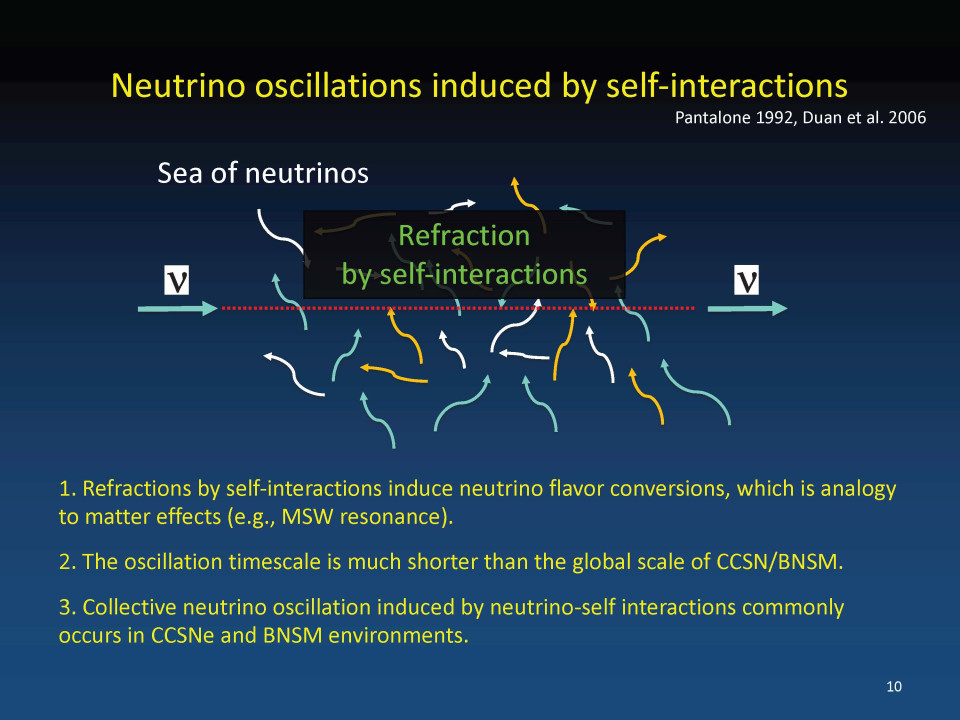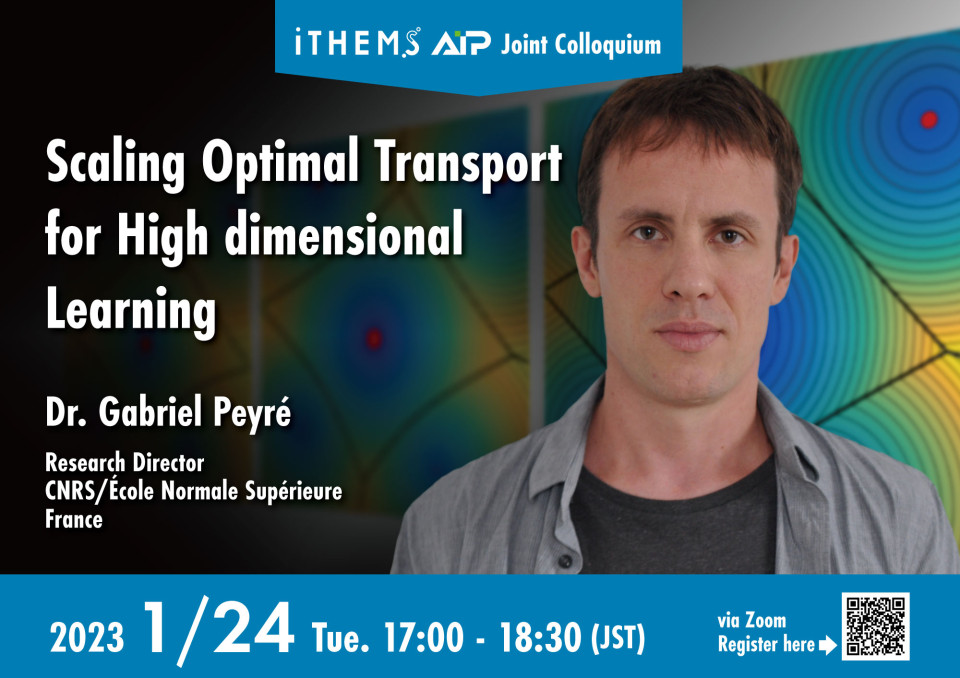Volume 229
Back to Newsletter List
Seminar Report
ABBL-iTHEMS Joint Astro Seminar by Dr. Ryo Higuchi on November 4, 2022
2022-12-12
Telescope Array (TA) and Auger experiments reported anisotropies in the arrival direction of ultra-high-energy cosmic rays (UHECRs). In the current correlation studies between UHECRs and source candidates, the Auger experiment reported a correlation between the flux model of assumed sources and UHECR events and suggested a 10% contribution of starburst galaxies (SBGs) to the anisotropy of UHECRs. However, they do not consider the effect of coherent deflection by the galactic magnetic field (GMF), and they should significantly affect the results of the correlation studies. In this talk, Dr. Ryo Higuchi introduced a current study of UHECR anisotropy and the effect of GMF on them.
Reported by Shigehiro Nagataki
UHECR anisotropy: effects of the Galactic magnetic field on the UHECR correlation studies
November 4 (Fri) 14:00 - 15:00, 2022
Seminar Report
ABBL-iTHEMS Joint Astro Seminar by Dr. Hiroki Nagakura on December 9, 2022
2022-12-12
Neutrinos are the most mysterious and elusive particles in the standard model of particle physics. They play important roles in core-collapse supernovae and binary neutron star mergers as driving mass-ejection, synthesizing heavy elements including r-process nuclei, and neutrino signals from these sources. This exhibits the importance of accurate modeling of neutrino radiation field in these phenomena, which will be used to connect neutrino physics to multi-messenger astronomy.
It has recently been suggested that neutrino-flavor conversion (or neutrino-oscillation) can ubiquitously occur in these astrophysical environments, exhibiting the requirement of quantum kinetic treatments in the modeling of neutrino transport. In this seminar, Dr. Hiroki Nagakura gave an overview of the quantum kinetics neutrino transport and then introduced its recent progress, paying a special attention to the connection to astrophysics. Dr. Hiroki Nagakura also presented the latest results of our numerical simulations of collective neutrino oscillations, which can be properly accounted for only by quantum kinetic framework.
Reported by Shigehiro Nagataki
Quantum kinetics of neutrinos in high-energy astrophysical phenomena
December 9 (Fri) 14:00 - 15:00, 2022
Upcoming Events
Seminar
DMWG Seminar
The ANDES Deep Underground Laboratory in South America: status and prospects
December 19 (Mon) 12:30 - 13:30, 2022
Maria Manuela Saez (Postdoctoral Researcher, RIKEN Interdisciplinary Theoretical and Mathematical Sciences Program (iTHEMS))
The construction of the Agua Negra tunnels that will link Argentina and Chile under the Andes mountains opens the possibility of building a deep underground laboratory in the Southern Hemisphere.
Dark Matter particles can be detected directly via their elastic scattering with nuclei, and next-generation experiments can eventually find physical evidence about dark matter candidates. I will show you our predictions for the expected direct dark matter signal and the ANDES site laboratory, whose location in the Southern Hemisphere should play a significant role in understanding dark matter modulation signals. Additionally, since planned next-generation large-scale direct detection experiments will measure the coherent elastic scattering of neutrinos on protons and nuclei, we have calculated the SN neutrino signal expected for the location. Finally, to study the background, we have calculated the contributions to the neutrino floor by considering the reactor’s neutrinos and geoneutrinos at the laboratory site. We hope these studies might contribute to dark matter detection strategies that maximize the future ANDES laboratory detection capabilities.
Venue: via Zoom
Event Official Language: English
Seminar
ABBL-iTHEMS Joint Astro Seminar
Modelling Optical Signals from Magnetar-Driven Supernovae
December 20 (Tue) 14:00 - 15:00, 2022
Conor Omand (Postdoctoral Researcher, Department of Astronomy, Stockholm University, Sweden)
Many energetic supernovae are thought to be powered by the rotational energy of a highly-magnetized, rapidly-rotating neutron star. The emission from the associated luminous pulsar wind nebula (PWN) can affect the system in different ways, including accelerating the ejecta, ionizing the ejecta, and breaking the spherical symmetry through hydrodynamic instabilities or large scale asymmetries. Modeling the observables from these processes; the light curves, spectrum, and polarization; is essential from understanding the nature of the central engine. I will present the results of a radiative transfer study looking at the effects of a PWN on the supernova nebular spectrum, and the preliminary results from a more physically motivated light curve model for parameter inference, and a study examining the polarization that arises due to hydrodynamic instabilities in the ejecta of engine-driven supernovae.
Venue: Common Room #246-248, 2F Main Research Building, RIKEN / via Zoom
Event Official Language: English
Seminar
iTHEMS Theoretical Physics Seminar
Tetra-neutron system studied by RI-beam experiments
January 17 (Tue) 13:30 - 15:00, 2023
Susumu Shimoura (Research Scientist, Spin isospin Laboratory, RIKEN Cluster for Pioneering Research (CPR))
Multi-neutron systems have attracted a long-standing attention in nuclear physics. In several decades, experimental attempts have been made with a particular focus on the tetra-neutron system. Among them, the two different experiments, the double-charge exchange reaction on 4He and the alpha-particle knockout reaction from the 8He, show a sharp peak just above the threshold in the four-neutron spectra, which could be a signature of a "resonant state", separate from a broad bump structure at higher excitation energy regions. Both the experiments have been realized by using the 8He beam above 150 A MeV at the RIKEN RI Beam Factory.
Details of the two experiments including basic idea, experimental techniques, and analysis are presented as well as a historical review of previous experimental attempts. Emphasis is made for the experimental conditions for populating a kinematically isolated tetra-neutron system with very small momentum transfer. The spectral shape is discussed by means of reaction processes and correlations in the final tetra-neutron system with several recent theoretical studies.
Venue: Common Room #246-248, 2F Main Research Building, RIKEN / via Zoom
Event Official Language: English
Seminar
ABBL-iTHEMS Joint Astro Seminar
Understanding kilonova spectra and identification of r-process elements
January 20 (Fri) 14:00 - 15:00, 2023
Nanae Domoto (Ph.D. Student, Department of Astronomy, Graduate School of Science, Tohoku University)
Binary neutron star (NS) merger is a promising site for the rapid neutron capture nucleosynthesis (r-process). The radioactive decay of newly synthesized elements powers electromagnetic radiation, as called kilonova. The detection of gravitational wave from a NS merger GW170817 and the observation of the associated kilonova AT2017gfo have provided with us the evidence that r-process happens in the NS merger. However, the abundance pattern synthesized in this event, which is important to understand the origin of the r-process elements, is not yet clear. In this talk, I will first introduce an overview and current understanding of kilonova. Then, I will discuss our recent findings of elemental features in photospheric spectra of kilonova toward identification of elements.
Venue: via Zoom
Event Official Language: English
Seminar
Information Theory Seminar
Physics-informed deep learning approach for modeling crustal deformation
January 23 (Mon) 10:30 - 11:30, 2023
Naonori Ueda (Deputy Director, RIKEN Center for Advanced Intelligence Project (AIP))
The movement and deformation of the Earth’s crust and upper mantle provide critical insights into the evolution of earthquake processes and future earthquake potentials. Crustal deformation can be modeled by dislocation models that represent earthquake faults in the crust as defects in a continuum medium. In this study, we propose a physics-informed deep learning approach to model crustal deformation due to earthquakes. Neural networks can represent continuous displacement fields in arbitrary geometrical structures and mechanical properties of rocks by incorporating governing equations and boundary conditions into a loss function. The polar coordinate system is introduced to accurately model the displacement discontinuity on a fault as a boundary condition. We illustrate the validity and usefulness of this approach through example problems with strike-slip faults. This approach has a potential advantage over conventional approaches in that it could be straightforwardly extended to high dimensional, anelastic, nonlinear, and inverse problems.
Reference
- Tomohisa Okazaki, Takeo Ito, Kazuro Hirahara & Naonori Ueda, Physics-informed deep learning approach for modeling crustal deformation, Nature Communications, vol. 13, Article number: 7092 (2022), doi: 10.1038/s41467-022-34922-1
Venue: via Zoom
Event Official Language: English
Colloquium
iTHEMS Colloquium
Scaling Optimal Transport for High dimensional Learning
January 24 (Tue) 17:00 - 18:30, 2023
Gabriel Peyré (Research Director, CNRS/École Normale Supérieure, France)
iTHEMS-AIP Joint Colloquium
Optimal transport (OT) has recently gained a lot of interest in machine learning. It is a natural tool to compare in a geometrically faithful way probability distributions. It finds applications in both supervised learning (using geometric loss functions) and unsupervised learning (to perform generative model fitting). OT is however plagued by the curse of dimensionality, since it might require a number of samples which grows exponentially with the dimension. In this talk, I will explain how to leverage entropic regularization methods to define computationally efficient loss functions, approximating OT with a better sample complexity. More information and references can be found on the website of our book "Computational Optimal Transport" (see related link below).
Venue: via Zoom
Event Official Language: English
Upcoming Visitor
December 20 (Tue) 2022 - February 7 (Tue) 2023 Masahiro NozakiVisiting Scientist, RIKEN Interdisciplinary Theoretical and Mathematical Sciences Program (iTHEMS) / Assistant Professor, Kavli Institute for Theoretical Sciences, University of Chinese Academy of Sciences, China Research fields: Elementary Particle Physics, Quantum Information Visiting Place: RIKEN Wako Campus |
Paper of the Week
Week 3, December 2022
2022-12-15
Title: On Quantum Information Before the Page Time
Author: Jonah Kudler-Flam, Yuya Kusuki
arXiv: http://arxiv.org/abs/2212.06839v1
Title: Morphological and anatomical analyses clarify the species definition of Ceratozamia latifolia Miq. (Zamiaceae) and lead to the description of a new species: Ceratozamia reesii
Author: Andrew P. Vovides, Miguel Angel Pérez-Farrera, María Magdalena Salinas-Rodríguez, Sonia Galicia, Pedro Díaz-Jiménez, Michael Calonje, José Said Gutiérrez-Ortega
Journal Reference: Phytotaxa
doi: https://doi.org/10.11646/phytotaxa.575.3.2
Title: Morphological variation between the two species of the palm genus Gaussia (Arecaceae) from Mesoamerica
Author: Nancy Gabriela Santos Hernández, Miguel Angel Pérez-Farrera, Luis E. Eguiarte, Andrew P. Vovides, José Said Gutiérrez-Ortega
Journal Reference: Nordic Journal of Botany
doi: https://doi.org/10.1111/njb.03770
Title: Numerical analysis for the Plateau problem by the method of fundamental solutions
Author: Koya Sakakibara, Yuuki Shimizu
arXiv: http://arxiv.org/abs/2212.06508v1
Title: MeV Gamma-Ray Source Contribution to the Inner Galactic Diffuse Emission
Author: Naomi Tsuji, Yoshiyuki Inoue, Hiroki Yoneda, Reshmi Mukherjee, Hirokazu Odaka
arXiv: http://arxiv.org/abs/2212.05713v1
Title: Attention in a family of Boltzmann machines emerging from modern Hopfield networks
Author: Toshihiro Ota, Ryo Karakida
arXiv: http://arxiv.org/abs/2212.04692v1
If you would like to cancel your subscription or change your email address,
please let us know via our contact form.
Copyright © iTHEMS, RIKEN. All rights reserved.






